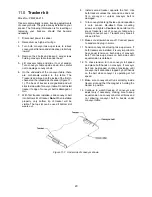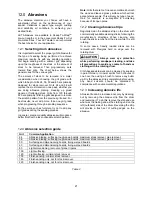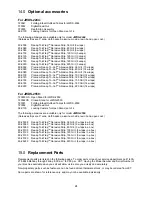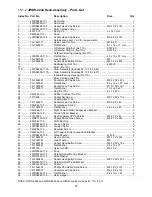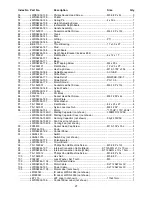
12
2. Release fastener lever to secure end of strip.
3. Begin wrapping abrasive around drum. The
tapered edge of strip end should follow as
closely as possible to edge of drum.
4. Continue wrapping abrasive in spiral fashion by
rotating drum with one hand and guiding strip
with the other. See Figure 6-8.
Successive windings of strip must
not have any
overlap.
They should be flush with previous
windings or with a slight gap between.
Figure 6-8
5. Press inboard take-up lever (Figure 6-9) and
insert trailing end of strip as far as it will go. If
necessary, trim tapered end of abrasive strip.
6. Release inboard take-up lever to secure strip.
All abrasive strips will stretch over time as they are
used, and may stretch enough to allow the take-up
lever to reach its lowest position so that it cannot
maintain tension on the strip. If this occurs, follow
the above procedures to reset the take-up lever.
Figure 6-9
7.0
Electrical connections
All electrical connections must
be done by a qualified electrician in compliance
with all local codes and ordinances. Failure to
comply may result in serious injury.
The JWDS-2244 and JWDS-2550 Sanders are
rated for single phase, 115-volt power only. The
sander comes with a plug designed for use on a
circuit with a grounded outlet that looks like the one
pictured in Figure 7-1.
Before connecting to power source, be sure switch
is in
off
position.
It is recommended that the sander be connected to
a dedicated 20 amp circuit with circuit breaker or
fuse. If connected to a circuit protected by fuses, use
time delay fuse marked “D”.
Local codes take
precedence over recommendations.
7.1
GROUNDING INSTRUCTIONS
This machine must be grounded. In the event of a
malfunction or breakdown, grounding provides a
path of least resistance for electric current to reduce
the risk of electric shock. This tool is equipped with
an electric cord having an equipment-grounding
conductor and a grounding plug. The plug must be
plugged into a matching outlet that is properly
installed and grounded in accordance with all local
codes and ordinances.
Do not modify the plug provided - if it will not fit the
outlet, have the proper outlet installed by a qualified
electrician.
Improper connection of the equipment-grounding
conductor can result in a risk of electric shock. The
conductor with insulation having an outer surface
that is green with or without yellow stripes is the
equipment-grounding conductor.
If repair or replacement of the electric cord or plug
is necessary, do not connect the equipment-
grounding conductor to a live terminal.
Check with a qualified
electrician or service personnel if the grounding
instructions are not completely understood, or if
in doubt as to whether the tool is properly
grounded. Failure to comply may cause serious
or fatal injury.
Use only 3-wire extension cords that have 3-prong
grounding plugs and 3-pole receptacles that accept
the tool's plug.
Repair or replace damaged or worn cord
immediately.
This tool is intended for use on a circuit that has an
outlet that looks like the one illustrated in Figure 7-
1. An adapter, shown in Figure 7-2, may be used to
connect this plug to a 2-pole receptacle as shown in
Figure 7-2 if a properly grounded outlet is not
available. The temporary adapter should be used
only until a properly grounded outlet can be installed
by a qualified electrician. The green-colored rigid
ear, lug, and the like, extending from the adapter
must be connected to a permanent ground such as
a properly grounded outlet box.
In Canada, the use of a temporary adaptor is not
permitted by the Canadian Electrical Code, C22.1.




















